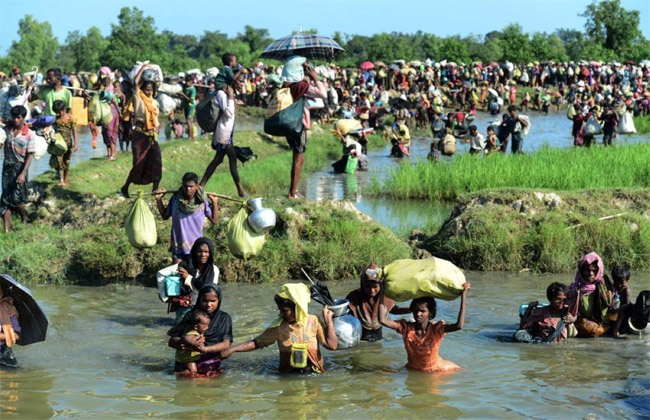
The Rohingya are the most persecuted minority group in the world. Such persecution has forced Rohingyas into Bangladesh for many years, with significant spikes following violent attacks in 1978, 1992, and again in 2016. More than 700,000 were forced to flee from Myanmar following a brutal military crackdown in 2017. Around 1.2 million Rohingyas are living in camps in Cox’s Bazar and Bashan Char in Bangladesh. At this point, there are more Rohingyas in Bangladesh than in Myanmar.
Following the Rohingya crisis, the socio-economic and security situation of Bangladesh is worsening. This crisis is currently at a deadlock and to bring momentum, Bangladesh needs its allies to repatriate such a huge number of people. With great power, comes great responsibility but so far, powerful countries did little to help Bangladesh repatriate this large number of refugees. In this regard, the USA is helping way more than any other countries, namely China and India, when it comes to discuss thishumanitarian problem. If China or India showed the same endeavors as the USA, this crisis would have more progress or even finished by now.
United States helping so far
The United States of America has pledged massive assistance to Bangladesh in its efforts to shelter Rohingyas. Since the crisis, the United States has been the single most important country in providing funds for Rohingya refugees. Since 2017, the United States has provided more than $1.9 billion in humanitarian assistance to people in Myanmar, Bangladesh, and other parts of the region. The United States was the largest contributor to the JRP fund in 2022, accounting for 50.1 percent of total funding.
It should be noted that Washington has offered to permanently resettle more than half a hundred Rohingyas skilled in various jobs in the United States. A list of more than half a hundred Rohingyas who have agreed to be resettled in the United States has also been recently shared with Dhaka. Out of many Rohingya refugees in Bangladesh, the resettlement of 600 Rohingya is not a big thing in terms of numbers, but it has a lot of political importance.
In December of last year, 24 of the selected 62 Rohingyas left Bangladesh for the United States as part of the US government’s resettlement program. According to the US Embassy in Dhaka, US President Biden reaffirmed the US commitment to welcoming refugees by keeping the total admissions target in the Presidential Determination on Refugee Admissions for 2022-23 at 125,000, with a regional allocation of 15,000 for East Asia.
US Secretary of State Antony Blinken, State Department Counsellor Derek Chollet, Assistant Secretary of the US Bureau of Population, Refugees, and Migration, Julieta Valls Noyes, and other top diplomats expressed the same ideology as Bangladesh that the ‘root cause of the Rohingya crisis lies in Myanmar’ and that ‘safe and dignified repatriation of Rohingyas to Myanmar’ is the only sustainable solution.
Bangladesh is deeply involved in a crisis that is completely Myanmar’s domestic problem. The USA wanted Myanmar and Bangladesh to deal with the situation bilaterally instead of having multilateral intervening forums but that did not work. So now it must negotiate with Myanmar diplomatically and bilaterally. The USA is taking concrete steps in favor of Bangladesh regarding the Rohingya refugees’ repatriation to Myanmar. A favorable situation should be created for the Rohingya refugees in Myanmar, where they can live without the fear of persecution.
China and India should follow USA’s footsteps
In the quest for a strategic role — India, China, and regional actors have yet to establish a concrete position, despite greater opportunities to extend their strategic presence and establish themselves as regional leaders by engaging in the Rohingya repatriation process and peace talks to end the crisis in Myanmar. Their contributions have been minimal in comparison to what the US has done so far. While the US is strongly supporting Bangladesh on the Rohingya issue, unfortunately, China and India’s geopolitical and geo-economic interests in Myanmar leave Bangladesh to manage the Rohingya crisis alone.
There is no doubt that the Rohingya crisis is a humanitarian issue. It is an issue of justice. The whole of South Asia and Southeast Asia may become volatile because of it. As a well-wisher, friend, and partner in the development process and trade, Bangladesh can expect the cooperation and support of China and India regarding the repatriation of Rohingya refugees to Myanmar. For regional stability and economic friendship, China and India should help and support Bangladesh and mediate in solving the crisis as soon as possible.
There seems to be no other way except repatriation, for Rohingya refugees, which has been a hanging case for the last five years. Regional countries wanted Myanmar and Bangladesh to deal with the situation bilaterally instead of having multilateral intervening forums but that did not work. To completely solve this crisis, Bangladesh needs all its allies. Also, regional countries, mainly China and India, need to be more involved. They should follow USA’s footsteps to repatriate the Rohingyas back to Myanmar. It is hoped that others neighboring countries will also help Bangladesh to get rid of this never-endingrefugee problem.
Erina Haque is a researcher and freelance columnist


